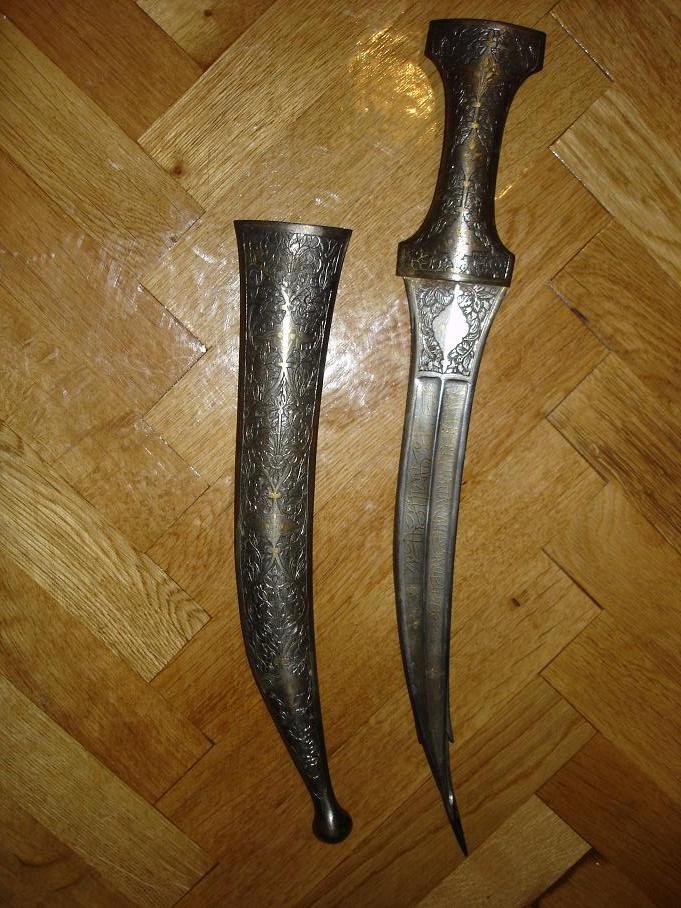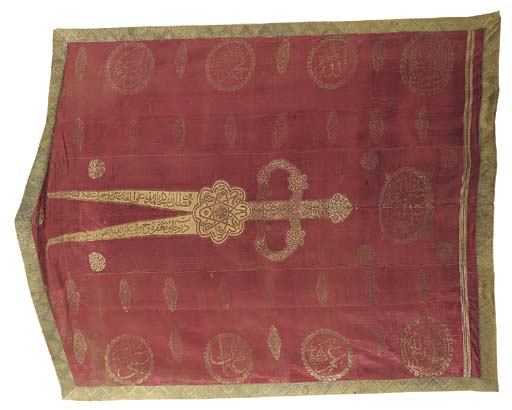| Author |
Message |
|
Russ Ellis
Industry Professional
|
|
  |
 |
|
C. Stackhouse
|
 Posted: Mon 19 Dec, 2005 7:07 am Post subject: Posted: Mon 19 Dec, 2005 7:07 am Post subject: |
 |
|
All of those barbs, separated blades and thin profile would suggest it was used for assassinations, it would slide into the victim quite easily and all of the wounds would be a pain-and-a-half in the ass to treat medically. It's construction and sheath/handle design suggests Indian origin (or somewhere thereabouts). Just look at some katar designs; scissor-like punching daggers and others with blades, hidden inside of other blades! From my knowledge I haven't seen many, if any other cultural area do this with their weapons.
Perhaps it was used in tandem with poison? The added surface area would be more receptive to it and the metal sheath would prevent leakage.
I could be wrong though 
|
|
  |
 |
|
Jeremy Eskin
|
 Posted: Mon 19 Dec, 2005 8:32 am Post subject: Posted: Mon 19 Dec, 2005 8:32 am Post subject: |
 |
|
|
I have seen middle eastern swords, cavalry weapons, with "forked" blades like that. I do not have any pictures, but hopefully some one else can expand on this, I personally am also very curious myself. I would guess that it might even just be a style. The sword I saw was long and curved and was a single blade up until the last 8 inches or so in which it forked off into two blades. maybe it would have inflicted some kind of double wound, my question would be how sturdy was this, the piece I saw was in very good shape in the atlanta arms museum I believe. This is my first post btw so hey everybody I have learned alot on this forum.
|
|
  |
 |
Greyson Brown

|
 Posted: Mon 19 Dec, 2005 9:24 am Post subject: Posted: Mon 19 Dec, 2005 9:24 am Post subject: |
 |
|
Well quite obviously, it's one of "them." And, of course, I ain't never seen any others before, so it's the neatest darn one of "them" I've seen.
More seriously, I really don't know what it is, but it strikes me more as a tool than a weapon. I say that for two reasons, one the blade is shaped rather like a filet knife, and so my mind just jumps to that conclusion. The other is the animals (a lion and an impala?) on the ricasso. Makes me tend to think it is some bizarre hunting knife. I don't have any idea why the bade would be shaped like that though...
-Grey
By the way, Jeremy, glad to have you. Enjoy!
"So long as I can keep the path of honor I am well content."
-Sir Arthur Conan Doyle, The White Company
|
|
  |
 |
|
Allan Senefelder
Industry Professional
|
 Posted: Mon 19 Dec, 2005 10:23 am Post subject: Posted: Mon 19 Dec, 2005 10:23 am Post subject: |
 |
|
|
Its a sub calss of the jimbya fmilly of curved islamic knives found everywhere from Morocco to India. I have seen these a few times before but don't recall exactly what the tines are for. I am not 100% but I don't thnik they serve the same prupose as the scissors katar with its blade inside a blade layout. They were meant to be used for parrying like a main gauche.
|
|
   |
 |
|
Sam Barris
|
 Posted: Mon 19 Dec, 2005 12:49 pm Post subject: Posted: Mon 19 Dec, 2005 12:49 pm Post subject: |
 |
|
As for the forked blade, it seems to me that a wound inflicted by something like that would be almost impossible to treat. The cuts would be so close together that trying to stitch one closed would probably tear any adjacent ones open wider.
Just a thought. Or maybe they made it just to look cool and scary.
Pax,
Sam Barris
"Any nation that draws too great a distinction between its scholars and its warriors will have its thinking done by cowards, and its fighting done by fools." —Thucydides
|
|
   |
 |
|
Russ Ellis
Industry Professional
|
|
  |
 |
Mikko Kuusirati

|
|
  |
 |
Jean Thibodeau

|
 Posted: Mon 19 Dec, 2005 8:33 pm Post subject: Posted: Mon 19 Dec, 2005 8:33 pm Post subject: |
 |
|
I tend to like the poison blade idea as a possibility to consider, or ( Joke ) an apple peeler. 
You can easily give up your freedom. You have to fight hard to get it back!
|
|
  |
 |
|
Jean-Carle Hudon
|
 Posted: Wed 21 Dec, 2005 10:04 am Post subject: Posted: Wed 21 Dec, 2005 10:04 am Post subject: |
 |
|
The style is that of an Indian peshkabz, a good example of which can be seen in Leslie Southwick's Price guide to Antique Edged Weapons, page232,no.713. The length is also consistent with other models shown. I would think it originates in the Portuguese colonies in India as the figure on the scabbard is reminiscent of Portuguese sea captain of the sixteenth and seventeenth centuries. The split in the blade is a nasty innovation on how to inflict the most damage to one's kidneys with the least repetitive motions. It can't be muslim because of the representation of a human figure in the art work, also the tiger attacking the antelope reinforces the idea of an Indian provenance. And by the way, nice scabbards, I enjoyed looking at your work.
Bon coeur et bon bras
|
|
  |
 |
|
C. Stackhouse
|
 Posted: Wed 21 Dec, 2005 8:02 pm Post subject: Posted: Wed 21 Dec, 2005 8:02 pm Post subject: |
 |
|
Kidneys?!  *shudder* *shudder*
|
|
  |
 |
|
Russ Ellis
Industry Professional
|
 Posted: Wed 21 Dec, 2005 11:08 pm Post subject: Posted: Wed 21 Dec, 2005 11:08 pm Post subject: |
 |
|
| Jean-Carle Hudon wrote: | | The style is that of an Indian peshkabz, a good example of which can be seen in Leslie Southwick's Price guide to Antique Edged Weapons, page232,no.713. The length is also consistent with other models shown. I would think it originates in the Portuguese colonies in India as the figure on the scabbard is reminiscent of Portuguese sea captain of the sixteenth and seventeenth centuries. The split in the blade is a nasty innovation on how to inflict the most damage to one's kidneys with the least repetitive motions. It can't be muslim because of the representation of a human figure in the art work, also the tiger attacking the antelope reinforces the idea of an Indian provenance. And by the way, nice scabbards, I enjoyed looking at your work. |
Wow Jean! Thanks for the information and thanks for the compliment!  I'll pass the info along to the interested parties and as for the scabbards... well they are still a work in progress... you see I got these new ideas the other day... I'll pass the info along to the interested parties and as for the scabbards... well they are still a work in progress... you see I got these new ideas the other day... 
TRITONWORKS Custom Scabbards
|
|
  |
 |
Andrew Winston

Location: Florida, USA Joined: 17 Nov 2003
Posts: 93
|
 Posted: Mon 26 Dec, 2005 10:02 am Post subject: Re: What is this thing Posted: Mon 26 Dec, 2005 10:02 am Post subject: Re: What is this thing |
 |
|
| Russ Ellis wrote: | Hey Everyone,
Someone over on another forum was asking what this thing was... I'm clueless but thought there was bound to be somone here who knows... anyone have a clue?
http://members.aol.com/tomyze/dagger.htm |
Hi Russ,
I understand these are muslim decorative knives. The split tip probably has no functional value. Rather, it is intended to invoke Zulfiqar (Dhu-l-Faqqar), the sword of the prophet Muhammad and his nephew Ali ibn Abi-Taaleb.


Split or forked tip Muslim swords are often seen as well. Here's a version that's likely Indian (based, in part, on the hilt):

The Topkapi Museum in Turkey has a few swords with this feature, including one claimed to be the original. I can't locate the photos I saved right now, though.
Here's a 19th Century Ottoman Flag with a stylized version:

Best regards and Happy Holidays,
Andrew
"I gave 'em a sword. And they stuck it in, and they twisted it with relish.
And I guess if I had been in their position, I'd have done the same thing."
-Richard Milhous Nixon
|
|
   |
 |
|
Russ Ellis
Industry Professional
|
|
  |
 |
Andrew Winston

Location: Florida, USA Joined: 17 Nov 2003
Posts: 93
|
 Posted: Wed 28 Dec, 2005 12:05 pm Post subject: Posted: Wed 28 Dec, 2005 12:05 pm Post subject: |
 |
|
My pleasure, Russ. 
"I gave 'em a sword. And they stuck it in, and they twisted it with relish.
And I guess if I had been in their position, I'd have done the same thing."
-Richard Milhous Nixon
|
|
   |
 |
|
|

